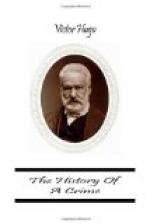None escaped. The guns and pistols were fired at close quarters.
New Year’s-day was not far off, some shops were full of New Year’s gifts. In the passage du Saumon, a child of thirteen, flying before the platoon-firing, hid himself in one of these shops, beneath a heap of toys. He was captured and killed. Those who killed him laughingly widened his wounds with their swords. A woman told me, “The cries of the poor little fellow could be heard all through the passage.” Four men were shot before the same shop. The officer said to them, “This will teach you to loaf about.” A fifth named Mailleret, who was left for dead, was carried the next day with eleven wounds to the Charite. There he died.
They fired into the cellars by the air-holes.
A workman, a currier, named Moulins, who had taken refuge in one of these shot-riddled cellars, saw through the cellar air-hole a passer-by, who had been wounded in the thigh by a bullet, sit down on the pavement with the death rattle in his throat, and lean against a shop. Some soldiers who heard this rattle ran up and finished off the wounded man with bayonet thrusts.
One brigade killed the passer-by from the Madeleine to the Opera, another from the Opera to the Gymmase; another from the Boulevard Bonne Nouvelle to the Porte Saint Denis; the 75th of the line having carried the barricade of the Porte Saint Denis, it was no longer a fight, it was a slaughter. The massacre radiated—a word horribly true—from the boulevard into all the streets. It was a devil-fish stretching out its feelers. Flight? Why? Concealment? To what purpose? Death ran after you quicker than you could fly. In the Rue Pagevin a soldier said to a passer-by, “What are you doing here?” “I am going home.” The soldier kills the passer-by. In the Rue des Marais they kill four young men in their own courtyard. Colonel Espinasse exclaimed, “After the bayonet, cannon!” Colonel Rochefort exclaimed, “Thrust, bleed, slash!” and he added, “It is an economy of powder and noise.” Before Barbedienne’s establishment an officer was showing his gun, an arm of considerable precision, admiringly to his comrades,




